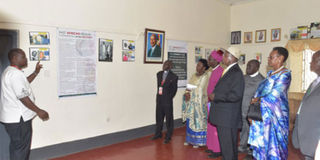Spiritual relics offer memorable treat

Abraham Ahabwe, one of the custodians of the museum, explains to the guests including the President and his wife at the launch of the museum. PHOTO/RAJAB MUKOMBOOZI
East Africa Revival Museum is about three kilometres off Mbarara-Bushenyi Road at Kamomo Stage on Ruharo hill, the home of Ankole diocese in Kamukuzi division, Mbarara city. Sitting in a soothing environment, surrounded by trees, birds chirp, and a signpost that stands opposite Ruharo Mission Hospital reads: East African Revival Museum.
If you use a boda boda it costs Shs2,000 and by cab Shs10,000 from Mbarara City centre.
The building was the first house used by the Church Missionary Society (CMS) around 1930 and has been the home of the past five bishops of Ankole Diocese. It stands next to the house of the Ankole Diocese bishop.
Opened in September 2016, the museum houses artifacts, documentaries, and research work on religious beliefs and practices as well as revival vanguards. It accommodates 20 people at once and it takes an hour for the curator to guide you around.
“We can accommodate100 people because we have other facilities such as a library, prayer garden and a restaurant, “says Abraham Ahabwe, one of the custodians at this museum.
The museum was birthed out of the revival (Born Again) movement which started in Gahini, Rwanda 1931 before spreading to Kigezi and Ankole in 1935 and 1936 respectively. From western region, Revival extended to other parts of the country and the rest of East Africa.
Here are photos that depict traditional ways of worship, the missionaries and Uganda martyrs. Among those recorded as native forerunners of Revival in East Africa are William Nagenda, Semyoni Nsibambi, Zaburoni Kabaza, Yosam Mucokoori, Edward Kakudiidi, Amos Rwabihiga and Elieza Mugimba.
There are also portraits of leaders such as Kabaka Mwanga who fought religion and those that supported it such as Edward Suleiman Kahaya, the Omugabe of Ankole and his premier Nuwa Mbaguta. Kahaya and Mbaguta donated land for establishment of the churches.
Guests
Visitors include researchers, academicians, pupils and students. They mostly visit the ‘Brethren Room’ to see pictures and hear stories/profiles of the early believers.
There is a special section of the Late Janani Luwum, which was commissioned last year.
During Janani Luwum National Day celebrations, hundreds of Christians thronged the museum to revisit history of a man that left an indelible mark.
Ahabwe says since the museum was opened in 2016, people seem to relate to the stories of some of the artifacts as some were witnesses on how some things unfolded.
“When we launched Janani Luwum exhibition on February last year, one of the guests was a doctor who used to work at Mulago Hospital. He narrated to us how he was among the people that were forced to do a fake post mortem of Janani Luwum,” Ahabwe recalls.
“The museum also connects believers to roots of their faith and restores others to follow Jesus Christ. It also gives them courage to speak about injustice in society as depicted by characters such as Janani Luwum,” adds Ahabwe.
Hellen Kyomugisha, one of the visitors, says if all religious leaders emulated Janani Luwum, and stood by truth and justice, the country would be short of challenges such as poor service delivery.
“I think religious leaders are letting us down, they do not tell the truth to our leaders. Janani Luwum told the truth and he was killed. He left a mark as a man for God chosen to liberate mankind,” Kyomugisha says.
“The challenges of corruption, poor service delivery, inequality are because religious leaders are in bed with politicians and can’t tell them the truth,” Kyomugisha says.
The museum also details how revival marked the age of enlightenment of society from witchcraft to science and rationale.
“The main objective of the museum is to preach the gospel. We retell the history of Christianity through research, artifacts, write ups, exhibitions, and pictorials. It will help to instill unshakeable faith in the young and old,” says Bishop Sheldon Mwesigwa.
He adds that from the Late Janani Luwum section, people learn his history and preaching which reminds Christians that despite the prevailing circumstances they should stick to the truth, sacrifice and seek justice to save society.
Retired clergy Canon William Ganafa, says the museum is an additional source of income to the diocese and contributes to tourism development in the region.
Refresh knowledge
Mary Baryamujura, the chairperson of the museum, says the resource centre has many characters of integrity that preached the gospel and transformed society.
“Characters such as Festo Kivengere, Eric Sabiti, and Janani Luwum were the people that stood for the truth and dedicated their lives to serve God,” says Baryamujura.
The management of the museum has contacts of nearby places of accommodation in case one must spend a night.
Tit bits…
To access the East Africa Revival Museum adults pay Shs5,000 and children pay Shs3,000.
• Visitors like the St James Cathedral Ruharo register of weddings and baptisms that date back to 1901 when Christianity came to Ankole.
• The most treasured artifact is the drum from the 1900s that the Kingdom of Ankole donated to the Church when Christianity came to Ankole.




